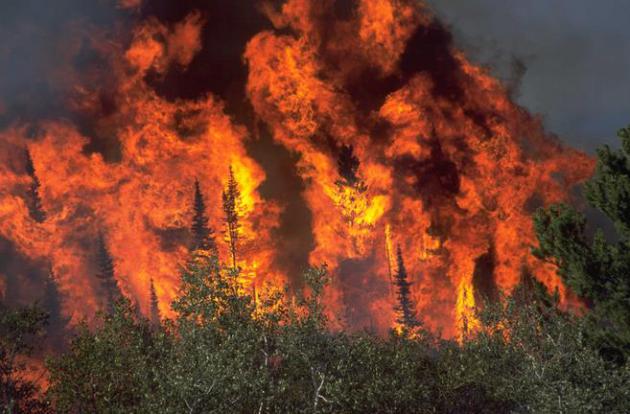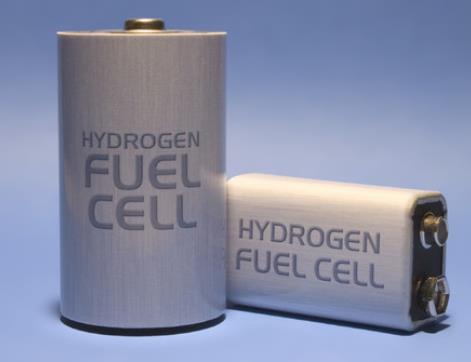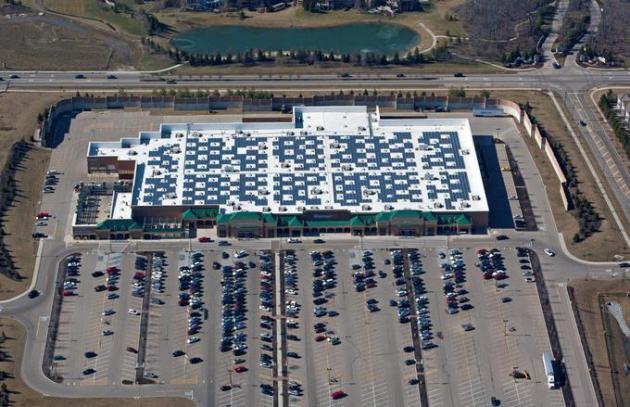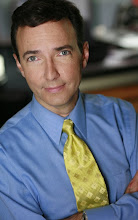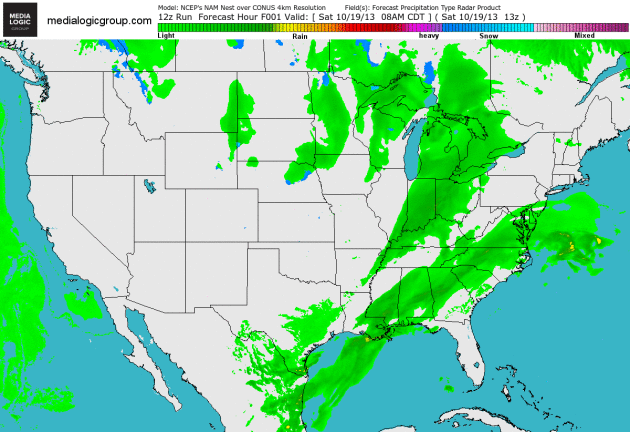
It’s Clipper-Time Again. 4km. NAM model data shows a pinwheel of precipitation pushing across Minnesota today, rain starting and ending as a little slushy mix, especially central and northern Minnesota. Meanwhile rain is possible across portions of the south later today into Monday. Loop: NOAA and Ham Weather
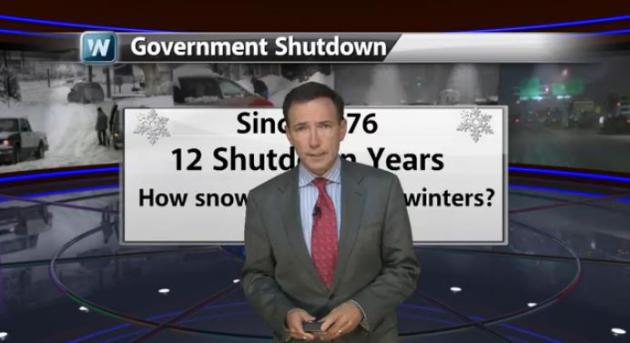
Bigfoot Made Me Do It. I’m not suggesting there’s an ironclad causal correlation between government shut-downs and snow, but at this point nothing would surprise me. When it comes to any long-range weather prediction buyer beware. Everone wants to know what the weather will be like on Christmas Day, but that doesn’t mean the science can support it. Winters are trending milder, so the (safer) bet would probably be another slightly-milder-than-average winter for Minnesota. Snow? In recent years about 1 in 3 winters have brought snowier than average (55″) winters. We had one last winter. Two in a row? Could we be that lucky? Don’t hold your breath. Here’s an overview of today’s edition of
Climate Matters. I had way too much fun with this: “
Weather forecasts beyond ten, twelve, days should have warning labels! Meteorologist Paul Douglas explains how long range forecasts have little accuracy. An active hurricane season was predicted this year and we have seen the quietest season since 1968. Long range winter forecasts are just as tough.”
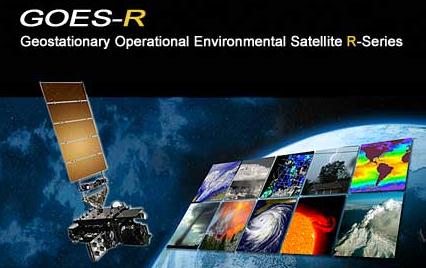
Shut-Down Could Delay NOAA Satellites, Climate Report. Andrew Freedman at
Climate Central has the story; here’s the intro: “
The 16-day government shutdown may have ripple effects throughout the government’s weather and climate programs. The National Oceanic and Atmospheric Administration (NOAA) has begun assessing whether the shutdown will cause further delays to its already troubled development of the next generation of weather and climate satellites. The satellites, which were already running billions over budget and years behind schedule before the shutdown, are considered critical to maintaining the accuracy of U.S. weather and climate forecasts…”
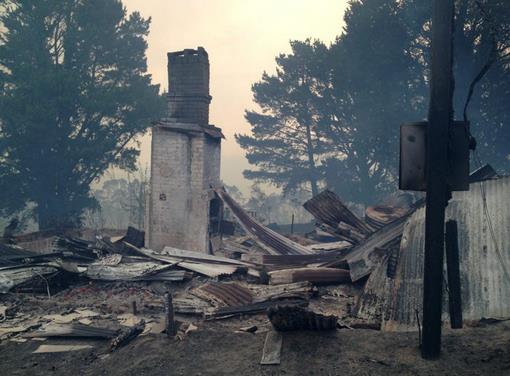
Raging Australian Wildfires Raise Questions About Climate Change, Emergency Preparedness. After record winter warmth fire season is coming (very) early to Australia – raising fears of another catastrophic fire year. The Christian Science Monitor has the story – here’s a clip: “…More than 80 fires continue to burn across New South Wales, with over 20 blazes not yet contained, according to the Australian Broadcasting Corp. The early start to the bushfire season in New South Wales has prompted warnings that the state could face the same conditions that led to the 2009 fires in Victoria – the worst in Australian history. Those fires claimed 173 lives and caused more than $4 billion in damage…”
Photo credit: “In this photo provided by the New South Wales Rural Fire Service the remains of a structure are in a crumpled pile after a wildfire destroyed the building, at an unknown location in Australia, Thursday, Oct. 17, 2013. Nearly a hundred wildfires are burning across Australia’s New South Wales state, more than a dozen of which are out of control, as unseasonably hot temperatures and strong winds fanned flames across the parched landscape.” (AP Photo/New South Wales Rural Fire Service)
Report: Western Wildfires Growing More Intense, Insurers Deeply Concerned. As the Western USA continues to dry out over time wildfires are becoming more frequent and intense. The Washington Post’s Capital Weather Gang has more details; here’s a clip: “Wildfires have been particularly large and destructive in recent years. The three-year period between 2011 and 2013 alone saw:
This trend is particularly alarming not only to residents in areas that are prone to burn during the summer, but to the insurance companies who insure those in harm’s way…”
Wildfire: A Burning Issue For Insurers. The 36 page (PDF) from Lloyds of London is here.

After The Flood: Ski Areas Crank Up Cloud-Seeing Programs. Well, this should make local attorneys very happy, because when it comes to modifying the weather, tinkering with Mother Nature, you really can’t please all the people all of the time. Here’s a clip from a story at The Aspen Business Journal: “…Weather modification has historic roots in the Cold War era, when both the U.S. and Soviets looked at ways to weaponize weather, and more recently, U.S. intelligence agencies decided to help fund a far-reaching study aimed at determining if there’s a way to mitigate global warming with technology and engineering. Proponents have claimed for years that seeding can increase snowfall in targeted areas by as much as 15 percent. As a result, water providers like Denver Water, and big ski resorts, including Vail, Breckenridge and Winter Park, are all helping fund a $1 million cloud-seeding program in Colorado’s north-central mountains, hoping to improve ski conditions, as well as boost stream flows and reservoir storage…”

Best And Brightest. Only A Few Countries Are Teaching Children How To Think. Here’s an excerpt from an interesting article and book review at The Economist: “…This is a lesson Ms Ripley sees throughout her tour of “the smart-kid countries”. Children succeed in classrooms where they are expected to succeed. Schools work best when they operate with a clarity of mission: as places to help students master complex academic material (not as sites dedicated to excellence in sport, she hastens to add). When teachers demand rigorous work, students often rise to the occasion, whereas tracking students at different cognitive levels tends to “diminish learning and boost inequality”. Low expectations are often duly rewarded…”
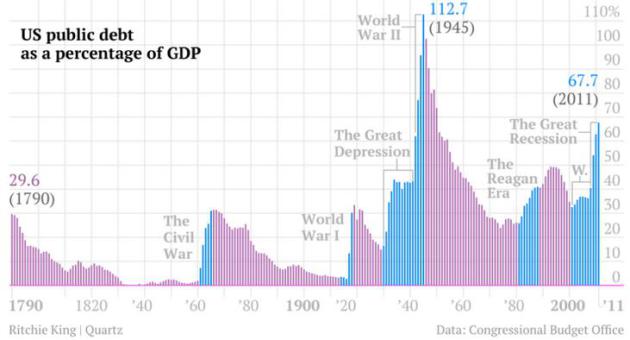
The Scary New Chapter Of America’s 223-Year Love Affair With Debt. Quartz provides some interesting perspective on our debt challenge/crisis – here’s an excerpt: “…A country’s reputation as a borrower is largely built on two things: ability to pay debts, and willingness to pay. As we said above, the US has the ability to pay. But willingness? That’s a political issue. Defaults by countries that were perfectly able to pay their debts have a long and rich history. A study of almost 170 government defaults dating back to the Napoleonic era showed almost 40% took place when economic growth was strong. That suggests that at least some were driven by politics rather than economics. “Many of these seemingly inexcusable defaults occurred when political upheavals brought new coalitions to power that favored default for opportunistic or ideological reasons,” the authors of the paper wrote…”

An Army Of Robot Baristas Could Mean The End Of Starbucks As We Know It. Say it isn’t so. Robots may be able to make a perfect latte, but what about idle banter and meaningless chit-chat at the cash register, huh? Here’s a clip from
Quartz: “
Starbucks’ 95,000 baristas have a competitor. It doesn’t need sleep. It’s precise in a way that a human could never be. It requires no training. It can’t quit. It has memorized every one of its customers’ orders. There’s never a line for its perfectly turned-out drinks. It doesn’t require health insurance. Don’t think of it as the enemy of baristas, insists Kevin Nater, CEO of the company that has produced this technological marvel. Think of it as an instrument people can use to create their ideal coffee experience. Think of it as a cure for “out-of-home coffee drinkers”—Nater’s phrase—sick of an “inconsistent experience…”
Photo credit above: “Finally, a barista you don’t have to lie to about how your day is going.” Briggo.
“Aeromobil”: A Flying Car Reimagined. I wonder if any of the current crop of flying car initiatives will get off the ground – I hope so. This is one good-looking car/plane; details from
Gizmag: “
There is a saying in flying: “If it looks good, it will fly well.” Stefan Klein, a designer from the Slovak Republic, has announced the first flight of his Aeromobil Version 2.5, a flying car prototype he has been developing over the last 20 years. This vehicle is a strikingly beautiful design with folding wings and a propeller in the tail. But will its flight capabilities match its looks?…”
* photo above: WeatherNation TV meteorologist Todd Nelson.
Climate Stories…
Rain Or No Rain, Beachfront Streets Flood Due To “Spring Tide”. Here’s a clip of a remarkable story at
The Miami Herald, where rising sea levels are already wreaking havoc. The city just sent a team to the Netherlands to explore the possibility of building a seawall, dikes or levees to keep the Atlantic out of South Beach. Here’s an excerpt: “…
Rodriguez said the city is thinking of short-term fixes to deal with the issue. “We’re looking at improving our sea walls and raising some of them,” she said. In search of a long-term solution, a delegation recently returned from the Netherlands, Rodriguez said, and the city will determine which of that country’s strategies to hold back high tides can be used here. “Some of their ideas we can do, others we can’t as we are in different geographic areas,” Rodriguez said. The current levels of high tide are caused by an astronomical event known as “spring tide,” according to Chuck Caracozza, a meteorologist from the National Weather Service…”
How Do You Get People To Give A Damn About Climate Change? Good question. It often hits home when it (literally) hits home, the atmospheric equivalent of a 2×4 across the forehead. Here’s an excerpt from Mother Jones: “…The two researchers agree that political ideology—and in particular conservative fiscal or free market thinking—is an overwhelming factor preventing acceptance of climate science. “A position on climate change has become almost like a tribal totem,” says Lewandowsky. “I am conservative, therefore I cannot believe in climate change.” But the difference is that Lewandowsky thinks other factors can mitigate this reality—including a consensus message that works, in essence, through peer pressure. After all, who wants to fly in the face of what 97 percent of experts have to say? “We know from my studies that if you can only tell people about the consensus, that it does make a huge difference to their belief,” Lewandowsky says…” (Image above: Skeptical Science).
Read more here: http://www.miamiherald.com/2013/10/17/3695685/rain-or-no-rain-beachfront-streets.html#storylink=cpy
Nobody In The Fuel Cell Industry Has Ever Made A Profit – This CEO Could Be The First. Expensive pipedream or new energy source with massive potential? Here’s a clip from
Quartz: “
The fuel cell industry has been the next big thing for nearly as long as it’s been around. Invented in the early 19th century, fuel cells are an efficient and clean way to produce energy. Hydrogen (the fuel) is pumped into a stack of various metals (the cell) in the form of natural gas or biogas. A chemical reaction produces electricity, water, heat and a negligible amount of carbon dioxide. Sounds great, right? That’s why over a dozen companies work in the industry. They make everything from multi-megawatt generators powering entire universities to little ones that power cars. Just last month eBay’s Utah data center went online, run entirely on fuel cells made by Bloom, a private company...”
The Truth About Denial. Sharon Begley, the senior health and science correspondent at Reuters, has a long, but fascinating post at
her web site; here’s an excerpt: “…
But outside Hollywood, Manhattan and other habitats of the chattering classes, the denial machine is running at full throttle—and continuing to shape both government policy and public opinion. Since the late 1980s, this well-coordinated, well-funded campaign by contrarian scientists, free-market think tanks and industry has created a paralyzing fog of doubt around climate change. Through advertisements, op-eds, lobbying and media attention, greenhouse doubters (they hate being called deniers) argued first that the world is not warming; measurements indicating otherwise are flawed, they said. Then they claimed that any warming is natural, not caused by human activities. Now they contend that the looming warming will be minuscule and harmless. “They patterned what they did after the tobacco industry,” says former senator Tim Wirth, who spearheaded environmental issues as an under secretary of State in the Clinton administration. “Both figured, sow enough doubt, call the science uncertain and in dispute. That’s had a huge impact on both the public and Congress…”
Solar Panels Are Sprouting On Business Rooftops Across The U.S. Here’s an excerpt from an interesting story at
The Denver Post. Are companies doing this to be altruistic, because they care about the environment? Maybe – but I would suggest that it has to do more with saving money over the long term: “
The 25 companies with the highest total solar capacity as of August 2013 have deployed about 445 megawatts at more than 950 different facilities, enough to power 73,400 American homes. That’s up from 300 megawatts and 730 facilities in 2012, according to 2013 “Solar Means Business” report from the trade group Solar Energy Industries Association and Vote Solar, a solar power advocacy group. The companies analyzed for the report had deployed systems in 30 states and Puerto Rico. The way was led by Walmart, Costco, Kohl’s and Apple…”
Photo credit above: “
Workers install solar panels at Ikea“.
Water Vapor In The Upper Atmosphere Amplifies Global Warming, Says New Study.
NOAA has the story – here’s the introduction: “
A new study shows that water vapor high in the sky and the temperature at the Earth’s surface are linked in a “feedback loop” that further warms our climate. Published today, this study gives the first estimate of the size of the feedback’s effect, which may help researchers improve modeling to better understand climate change. “Water vapor in the stratosphere increases in tandem with increases in the Earth’s surface temperature,” said coauthor Sean Davis, a scientist at the Cooperative Institute for Research in Environmental Sciences working at the NOAA Earth System Research Laboratory in Boulder, Colo. “Because water vapor is a greenhouse gas, this generates additional warming. We show that this feedback loop could be about 10% of the climate warming from all greenhouse gases…”
Iowa Scientists: Climate Change Affecting Farming. Here’s an excerpt of a story at
seattlepi.com: “
Several Iowa scientist are releasing a report on how they believe climate change is affecting farmers. A report “Iowa Climate Statement 2012: Climate Change Threatens Iowa Farms” will be released Friday at Drake University. Researchers and professors from Iowa State University, the University of Iowa, the University of Northern Iowa, Drake, and Mount Mercy University will release the report. The report looks at the extreme weather this year marked by the wettest spring on record followed by the second-driest July through September ever...”
Michael Mann, Off Battlefield, Discusses “Climate Wars”. Andrew Freedman has the story for
Climate Central; here’s the intro: “
Michael E. Mann sounds remarkably upeat these days considering that he has been under assault for more than a decade by investigations, criticisms, and even death threats for his work as a climate scientist. Perhaps he’s been buoyed by the fact that the Virginia Supreme Court recently halted State Attorney General and Republican gubernatorial candidate Ken Cuccinelli’s investigation into Mann’s use of state funds for climate research. That case, which was widely viewed as politically motivated, galvanized the climate science community because of the threat it posed to academic freedom and scientific inquiry…”
Climate Change Panel Features Varying Perspectives With Common Goal. Wisconsin’s
Badger Herald has the story – here’s a clip: “…
The benefits of cleaner air, because of public health costs, are you gain $49 on average from every ton of carbon dioxide you remove … the cost of cleaner energy is $30 on average per ton of carbon dioxide removed,” Patz said, drawing on evidence from a study conducted by fellow panelist Gregory Nemet, associate professor in Public Affairs and Environmental Studies. The gains of moving to cleaner energy clearly outweigh the costs, Patz said. Nemet said there is an exponential increase in temperature projected for the next 100 years. “We need to decarbonize at a rate of 5 percent or 6 percent per year,” Nemet said. “You can’t deny that people are burning coal. It’s cheap, domestic and extremely carbon intensive…”
Walmart Leads Companies Investing In Solar. Are they doing it to be altruistic, because it’s the right thing to do, for customers, shareholders and the environment? Possibly, but I suspect it’s because over the long term they can operate with greater efficiency, save money, and pass those savings along, making them even more competitive. Smart. Here’s a clip from
Daily Finance: “
Solar continues to “go through the roof” in the U.S. commercial sector. The Top 25 corporate solar users nationwide have deployed 445 MW of capacity thus far this year, up 48% over the same period in 2012, according to a report released this week. And leading the pack for the second consecutive year is America’s largest retailer, Wal-Mart , with 89 megawatts of photovoltaic capacity installed at 215 company facilities in 11 states. Those are the findings of “Solar Means Business 2013” study, conducted by the U.S. Solar Energy Industries Association, a trade group based in Washington, DC, in cooperation with the Vote Solar Initiative, a non-profit organization based in San Francisco…”
__________________________________________________________________
ABOUT ME
Welcome to the WeatherNation blog. Every day I sift through hundreds of stories, maps, graphics and meteorological web sites, trying to capture some of the most interesting weather nuggets, the stories behind the forecast. I’ll link to stories and share some of the web sites I use. I’m still passionate about the weather, have been ever since Tropical Storm Agnes flooded my home in Lancaster, PA in 1972. I’ve started 5 weather-related companies. “EarthWatch” created the world’s first 3-D weather graphics for TV stations – Steven Spielberg used our software in “Jurassic Park” and “Twister”. My last company, “Digital Cyclone”, personalized weather for cell phones. “My-Cast” was launched in 2001 and is still going strong on iPhone, Android and Blackberry. I sold DCI to Garmin in 2007 so I could focus on my latest venture: WeatherNation. I also write a daily weather column for The Star Tribune startribune.com/weather And if you’re on Twitter, you’ll find me @pdouglasweather.





